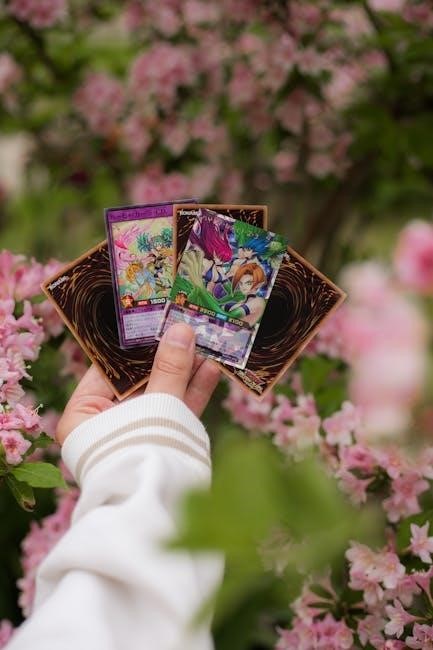The 5-4-3-2-1 grounding technique is a simple‚ evidence-based method to calm the mind and body by engaging the five senses. It helps individuals focus on the present moment‚ reducing anxiety and stress effectively.

What is the 5-4-3-2-1 Grounding Technique?
The 5-4-3-2-1 grounding technique is a mindfulness exercise designed to help individuals focus on the present moment by engaging all five senses. It involves sequentially identifying specific numbers of sensory experiences: 5 things you can see‚ 4 things you can touch‚ 3 things you can hear‚ 2 things you can smell‚ and 1 thing you can taste. This structured approach helps calm the mind and body‚ anchoring you in reality. It is particularly useful for managing anxiety‚ stress‚ or overwhelming emotions. The technique requires no equipment and can be practiced anywhere‚ making it a practical tool for everyday use. By shifting focus to tangible sensory details‚ it interrupts negative thought patterns and promotes emotional regulation. Grounding techniques like this are widely recommended by mental health professionals as an effective way to regain control during distressing moments. Their simplicity and accessibility make them a popular choice for individuals seeking quick relief from anxiety or panic.
Benefits of Using the 5-4-3-2-1 Grounding Technique

The 5-4-3-2-1 grounding technique offers numerous benefits‚ particularly for managing anxiety‚ stress‚ and overwhelming emotions. By focusing on sensory experiences‚ it helps individuals anchor themselves in the present moment‚ reducing feelings of panic or disconnection. This technique is highly accessible‚ requiring no special tools or preparation‚ making it ideal for use in any situation. It promotes emotional regulation by distracting the mind from negative thoughts and redirecting attention to tangible‚ grounding details. Regular practice can improve mental clarity and reduce the intensity of stressful emotions. Additionally‚ it is a simple yet effective tool for managing trauma-related symptoms‚ such as flashbacks‚ by refocusing awareness on the here and now. Its structured approach ensures consistency‚ making it easier for individuals to commit to regular practice. Overall‚ the 5-4-3-2-1 technique is a powerful‚ evidence-based method for enhancing emotional well-being and maintaining calm in challenging moments.

How to Practice the 5-4-3-2-1 Grounding Technique
The 5-4-3-2-1 grounding technique helps you focus on the present by engaging your senses. Identify five things you can see‚ four you can touch‚ three you can hear‚ two you can smell‚ and one you can taste. This simple‚ portable method calms the mind and reduces anxiety effectively.
Step 1: Identify 5 Things You Can See
Begin by observing your surroundings and listing five distinct objects or details you can see. These could be as simple as a chair‚ a painting‚ or patterns on the wall. Focus on their shapes‚ colors‚ and textures to enhance your mindfulness. This step anchors your attention in the present moment‚ helping to distract from overwhelming thoughts. By engaging your visual sense‚ you initiate the grounding process effectively‚ setting the stage for the subsequent steps. The goal is to be deliberate and thorough in your observations‚ ensuring each item is clearly noted in your mind. This practice not only calms the mind but also enhances sensory awareness‚ making it easier to stay grounded. Remember‚ the objects don’t need to be significant—attention to detail is key. This foundational step sets the tone for the rest of the exercise‚ promoting clarity and focus.
Step 2: Acknowledge 4 Things You Can Touch
Next‚ bring your attention to four things you can touch or feel physically. This could include the chair beneath you‚ the floor under your feet‚ or the texture of an object in your hand. Engage your sense of touch by noticing the sensations—whether something feels soft‚ rough‚ warm‚ or cool. This step deepens your connection to the present moment by grounding you through physical awareness. It’s important to focus on the sensations without judgment‚ simply acknowledging their presence. For example‚ you might notice the weight of your body on the chair‚ the air brushing against your skin‚ or the grip of your shoes on the ground. By focusing on touch‚ you further distract your mind from anxiety and anchor yourself in reality. This practice helps interrupt racing thoughts and promotes a sense of stability. Move through each sensation deliberately‚ ensuring you fully register each before proceeding.
Step 3: Notice 3 Things You Can Hear
Now‚ shift your focus to three things you can hear. This step engages your auditory sense‚ helping you further anchor in the present moment. Identify distinct sounds around you‚ such as birds chirping‚ a clock ticking‚ or people talking. It could also be subtle noises like the hum of a fan‚ rustling leaves‚ or distant traffic. The goal is to acknowledge each sound without judgment‚ simply recognizing its presence. By focusing on what you hear‚ you distract your mind from anxious thoughts and deepen your grounding. If the environment is quiet‚ pay attention to internal sounds‚ like your breathing or the beat of your heart. This practice enhances mindfulness and reduces emotional overwhelm. Take a moment to fully listen‚ ensuring each sound is clearly noted before moving forward. This auditory awareness strengthens your connection to reality‚ making it easier to manage stress or anxiety effectively. Continue with patience and intention‚ allowing the sounds to guide you back to calmness. The more you practice‚ the more natural this step becomes in grounding yourself during challenging moments.
Step 4: Recognize 2 Things You Can Smell
Next‚ focus on identifying two distinct smells in your environment. This step engages your sense of smell‚ further grounding you in the present. Take a deep breath and notice the scents around you‚ such as freshly brewed coffee‚ the aroma of flowers‚ or the earthy smell of grass. If indoors‚ you might detect the scent of candles‚ cleaning products‚ or cooked food. Even subtle smells‚ like the fragrance of soap or the natural scent of the air‚ count. Naming these smells aloud or in your mind enhances the experience. This practice helps shift your attention away from overwhelming thoughts by connecting you to tangible sensations. By focusing on smells‚ you deepen your mindfulness and create a stronger sense of calm. Allow yourself to fully experience these odors‚ recognizing their presence without judgment. This sensory engagement is a powerful tool for managing anxiety and staying grounded in the moment. Embrace the simplicity of this step to enhance its effectiveness.
Step 5: Focus on 1 Thing You Can Taste

Finally‚ bring your attention to one thing you can taste. This step engages your sense of taste‚ helping you anchor yourself in the present moment. Notice the flavor of gum‚ a sip of water‚ or the aftertaste of a snack. Even subtle tastes‚ like the hint of toothpaste or the natural flavor of your mouth‚ count. If you’re eating or drinking‚ focus on the texture and flavor of the item. This step encourages mindfulness and completes the grounding process by fully immersing you in your senses; The simplicity of this exercise makes it accessible anywhere‚ providing a quick way to calm your mind and body. By focusing on taste‚ you reinforce your connection to the here and now‚ enhancing the overall grounding effect. Allow yourself to savor this experience‚ no matter how small‚ to deepen your sense of calm. This step is a powerful conclusion to the technique‚ leaving you feeling centered and present. Use it to seal your practice and return to equilibrium.
Additional Tips for Effective Grounding
For enhanced grounding‚ combine the technique with deep breathing‚ practice in various environments‚ and use sensory-rich activities. Consistency and patience are key to mastering this powerful mindfulness tool for emotional balance and stress relief.
Using the Technique in Different Environments
The 5-4-3-2-1 grounding technique can be applied in any environment‚ making it a versatile tool for managing stress and anxiety. Whether at home‚ in nature‚ or in a bustling city‚ the technique helps individuals reconnect with their surroundings. For example‚ in outdoor settings like parks‚ one might notice sights like trees‚ flowers‚ or birds‚ while in indoor spaces‚ focusing on objects such as furniture‚ artwork‚ or household items can be effective. Even in crowded or noisy environments‚ the technique encourages mindfulness by shifting focus to tangible sensory experiences. Its portability and simplicity make it ideal for use during travel‚ at work‚ or in public places. By adapting the technique to different settings‚ individuals can enhance their emotional resilience and maintain balance in diverse situations. This flexibility ensures the 5-4-3-2-1 method remains a reliable grounding tool‚ regardless of where life takes you.
Combining Grounding with Deep Breathing
Enhance the effectiveness of the 5-4-3-2-1 grounding technique by pairing it with deep breathing exercises. Begin by taking slow‚ deliberate breaths‚ inhaling through the nose and exhaling through the mouth. This practice helps calm the nervous system‚ creating a foundation for grounding. As you move through the senses—acknowledging five things you see‚ four you touch‚ and so on—continue deep breathing to maintain focus. The combination of sensory awareness and controlled breathing amplifies relaxation‚ making it easier to anchor yourself in the present. This integrated approach is particularly beneficial during moments of heightened anxiety‚ as it provides both mental and physical stabilization. By synchronizing grounding with deep breathing‚ individuals can achieve a deeper state of calm and emotional regulation‚ making the technique even more powerful in managing stress and overwhelming emotions. This synergy offers a holistic method to restore balance and tranquility in daily life.


Resources for Further Learning
Explore downloadable PDF guides and recommended websites for in-depth insights into the 5-4-3-2-1 grounding technique. These resources offer step-by-step instructions‚ benefits‚ and variations to enhance your practice and understanding of this powerful mindfulness tool.
Downloadable PDF Guides on the 5-4-3-2-1 Technique
Downloadable PDF guides on the 5-4-3-2-1 grounding technique are widely available‚ offering a comprehensive and structured approach to mastering this mindfulness practice. These guides typically include step-by-step instructions‚ examples‚ and visual aids to help users understand and apply the technique effectively. Many PDFs are designed for quick reference‚ making them ideal for daily practice or sharing with others. They often feature lists of items to identify for each sense‚ along with tips for staying focused and present; Some guides also include variations of the technique‚ such as adapting it for specific environments or combining it with deep breathing exercises. Additionally‚ certain PDFs are tailored for specific audiences‚ such as children or trauma survivors‚ ensuring the technique is accessible to everyone. Websites like Youth and Family Therapy and the New Jersey Department of Education provide these resources free of charge‚ making it easy to explore and benefit from the 5-4-3-2-1 grounding method.
Recommended Websites for Grounding Exercises
Several websites offer valuable resources and guides on the 5-4-3-2-1 grounding technique. The Youth and Family Therapy website provides a detailed PDF guide that explains the technique and its benefits. Additionally‚ the New Jersey Department of Education website features a downloadable PDF titled “54321 Grounding Technique‚” which includes step-by-step instructions and examples. Other recommended websites include Psychology Today and Mindful.org‚ both of which offer articles and resources on grounding techniques. These websites are great for anyone looking to deepen their understanding of the 5-4-3-2-1 method and explore additional grounding exercises. They provide accessible and practical tools to help individuals manage anxiety and stay present in stressful situations.
